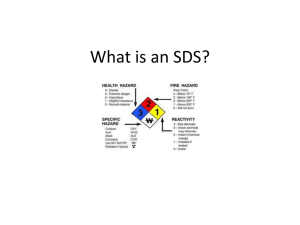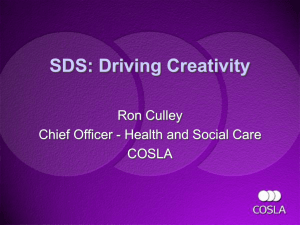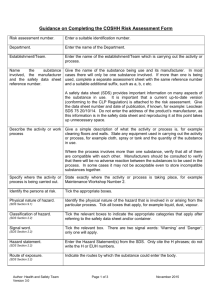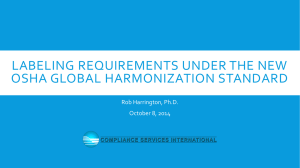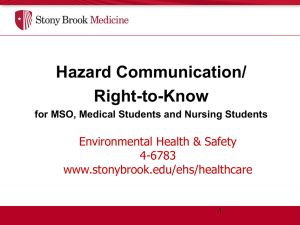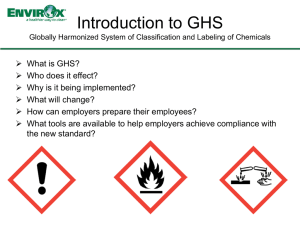HazCom 2012 Label/SDS Powerpoint
advertisement
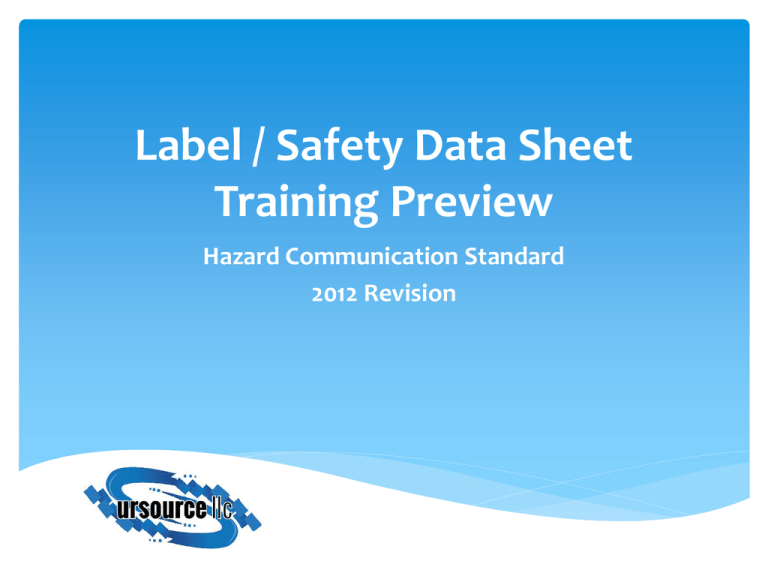
Label / Safety Data Sheet Training Preview Hazard Communication Standard 2012 Revision Hazard Communication Standard OSHA revised HazComm standard Global Harmonized System of Classification and Labeling of Chemicals (GHS) Changes in chemical labels and safety data sheets Goals of New Standard Provide a common and coherent look Enhance worker comprehension Reduce confusion Safer training Safer handling and use of chemicals Quicker and more efficient access to data sheets December 1st, 2013 Compliance deadline! All employees must be trained on new label elements and SDS format Label Information Pictogram Signal word Hazard statement Precautionary statement Product identifier and supplier information Reclassification Ratings GHS classification ratings order of severity differ from NFPA and HMIS: HMIS/NFPA 0 = least hazardous 4 = most hazardous GHS 5 = least hazardous 1 = more hazardous Label Pictograms Symbol on white background with red square frame 8 pictograms used by OSHA Pictogram: Health Hazard Carcinogen Mutagenicity Reproductive toxicity Respiratory sensitizer Target organ toxicity Aspiration toxicity Germ cell mutagens Pictogram: Flame Flammable Pyrophorics Self-heating Emits flammable gas Self-reactives Organic peroxides Pictogram: Exclamation Mark Irritant Skin sensitizer Acute toxicity Narcotic effects Respiratory tract irritant Hazardous to ozone layer Pictogram: Gas Cylinder Gases under pressure Pictogram: Corrosion Skin corrosion/burns Eye damage Corrosive to metals Pictogram: Exploding Bomb Explosives Self-reactives Organic peroxide Pictogram: Flame Over Circle Oxidizers Pictogram: Skull & Crossbones Acute toxicity Fatal or toxic Signal Word Single word Danger – severe hazards Warning – less severe Hazard Statement Assigned to hazard class and category Nature of hazard Degree of hazard “Causes serious eye irritation” “Highly flammable liquid and vapor” Precautionary Statement Minimize/prevent adverse effects from exposure, improper storage, or handling “Keep away from heat” “Wear protective gloves/clothing” Sample Label SDS – Safety Data Sheets Replaces MSDS 16 sections listed in specific order Can use MSDS and SDS sheets during transition Recommend changing to SDS when available SDS – Section 1: Identification Product identifier Manufacturer’s contact information Recommended uses of the product Emergency phone number SDS – Section 2: Hazard Identification Pictograms Hazard statement Signal words Precautionary statement Unclassified hazards SDS – Section 3: Composition/Information on Ingredients Chemical name Common name and synonyms List of all ingredients SDS – Section 4: First-Aid Measures Initial care steps responding to exposure Lists the most significant effects Acute and delayed effects Immediate medical attention Special treatment if necessary SDS – Section 5: Fire-Fighting Measures Recommendations for fighting fire caused by product Special protective equipment and precautions Risks developed during the fire – hazardous combustion SDS – Section 6: Accidental Release Measures Appropriate response to spills or leaks of product Methods and materials for containment/clean up Precautions, protective equipment Emergency procedures SDS – Section 7: Handling & Storage Precautions for safe handling Conditions for safe storage SDS – Section 8: Exposure Controls & Personal Protection Measures to minimize worker exposure OSHA PEL exposure limits PPE personal protection SDS – Section 9: Physical & Chemical Properties Appearance Odor pH Melting/freezing points Density Threshold Pressure SDS – Section 10: Stability & Reactivity Conditions to avoid Reactivity Chemical stability Possible hazardous reactions Incompatible materials SDS – Section 11: Toxicological Information Toxicological effects Likely exposure routes Delayed and immediate effects of exposure Chronic effects from short and long term exposure SDS – Section 12: Ecological Information Not mandatory Information on the environmental impact the product causes SDS – Section 13: Disposal Information Proper disposal and recycling methods Related to product and container Safe handling SDS – Section 14: Transport Information Classification for shipping and transport Special precautions if necessary SDS – Section 15: Regulatory Information Safety regulations Health regulations Environmental regulations SDS – Section 16: Other Date of preparation of SDS Date of last revision made What changes were made Sample SDS How to Prepare? • • • • • • Gather new standard information Plan the transition Inventory in-house chemicals Update MSDS documentation Update workplace labels Schedule/conduct training Implementation December 1, 2013 – employees trained on SDS/labels June 1, 2015 – manufacturers must comply with all final rules and provisions December 1, 2015 – distributors must cease shipping products with old labeling June 1, 2016 – update all labeling and hazard programs in the workplace Resources www.ursourcellc.com www.osha.gov/dsg/hazcom/index.html www.osha.gov/Publications/OSHA3642.pdf Training Fact Sheet
